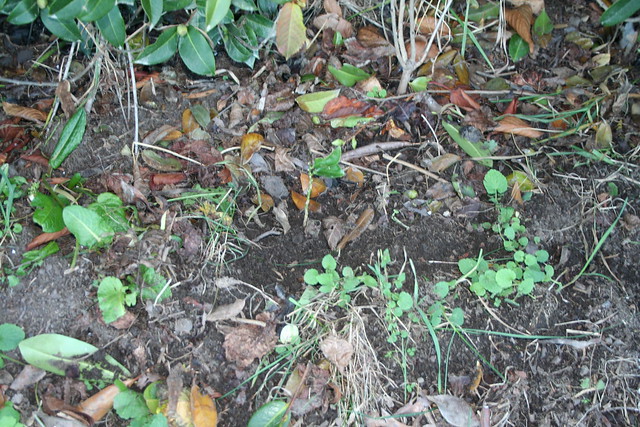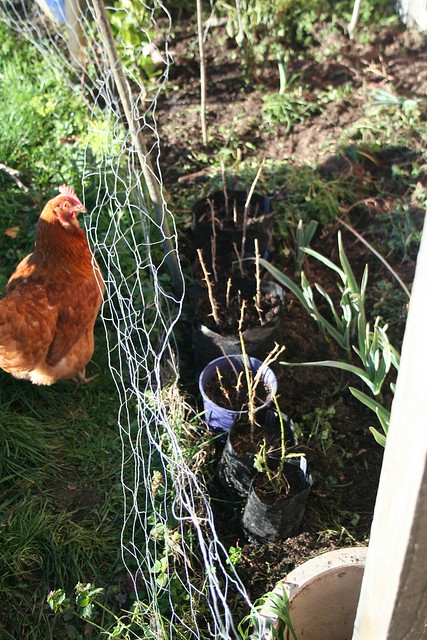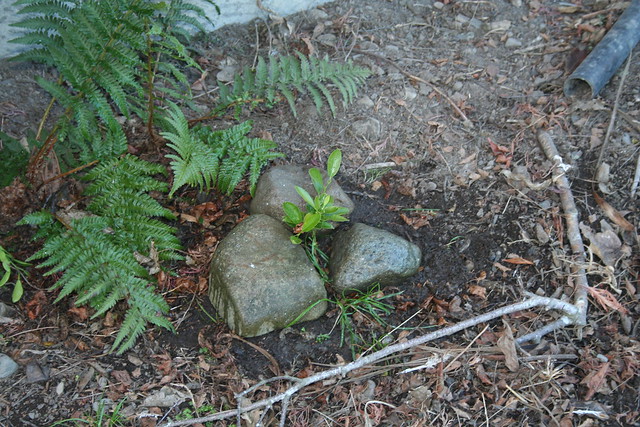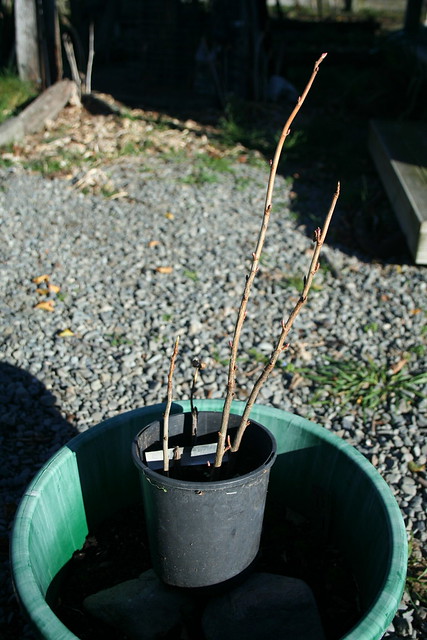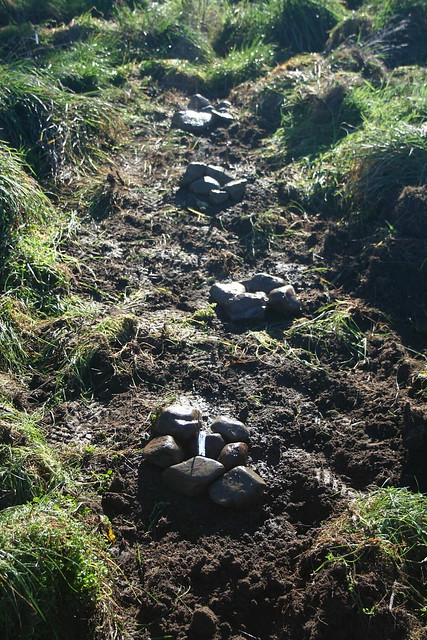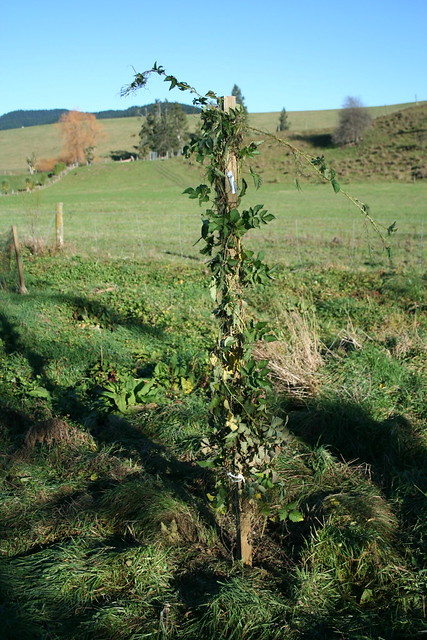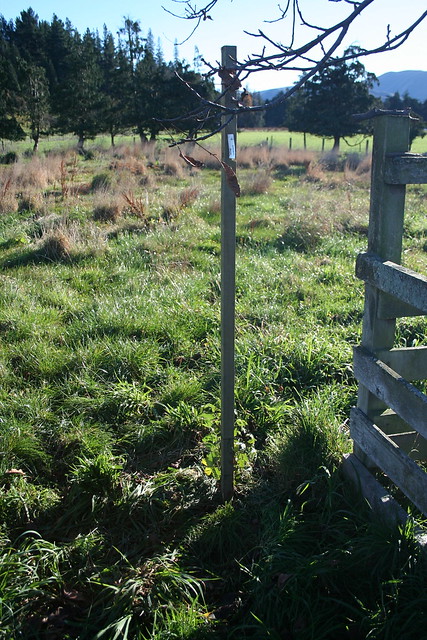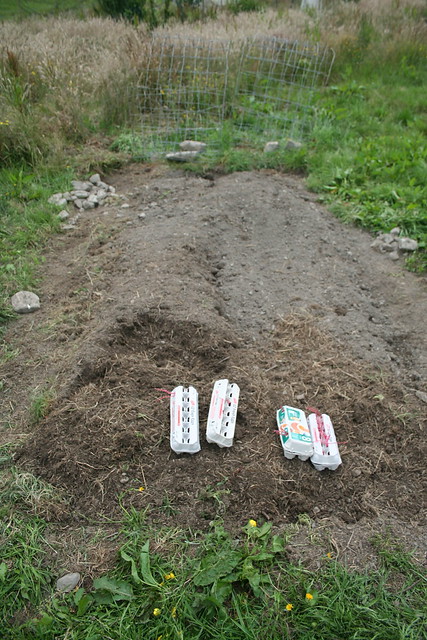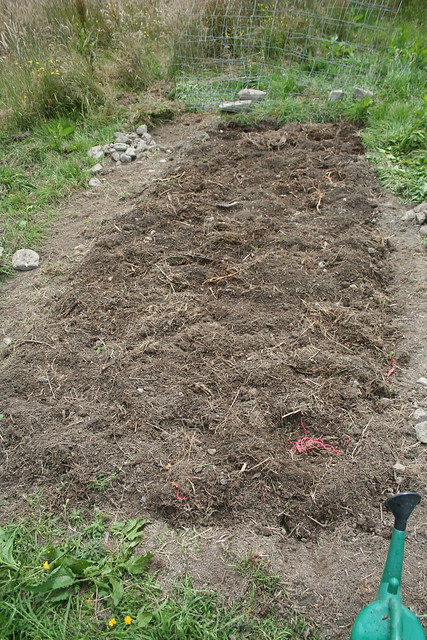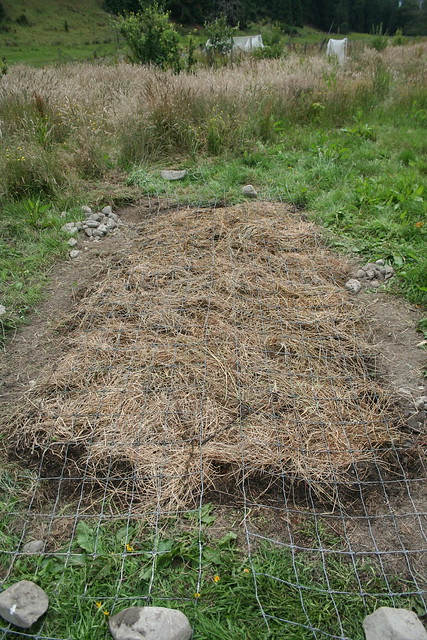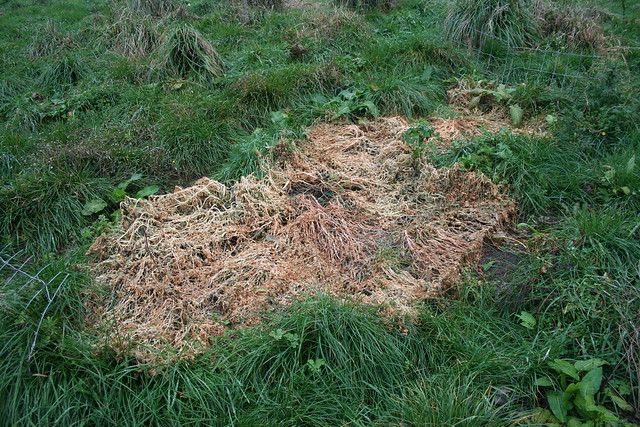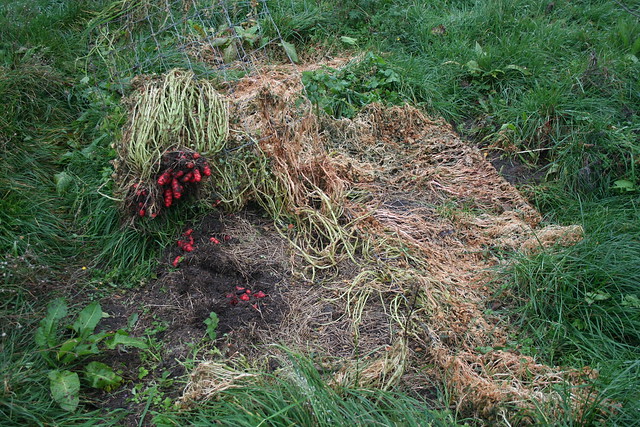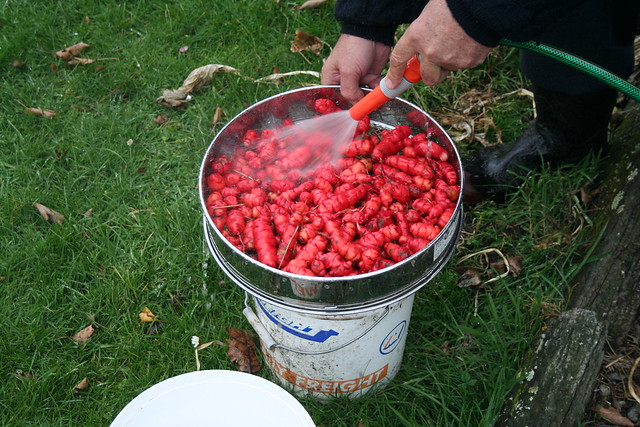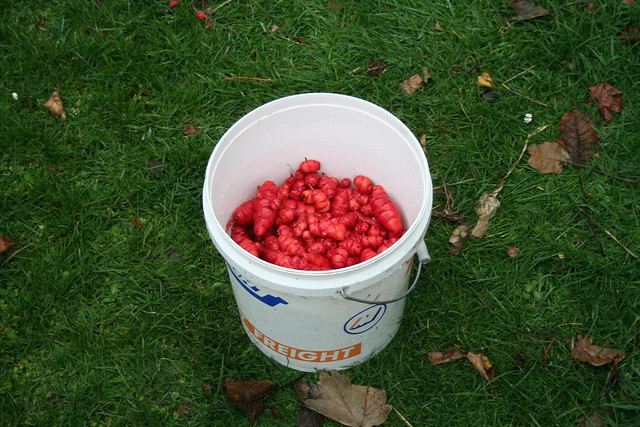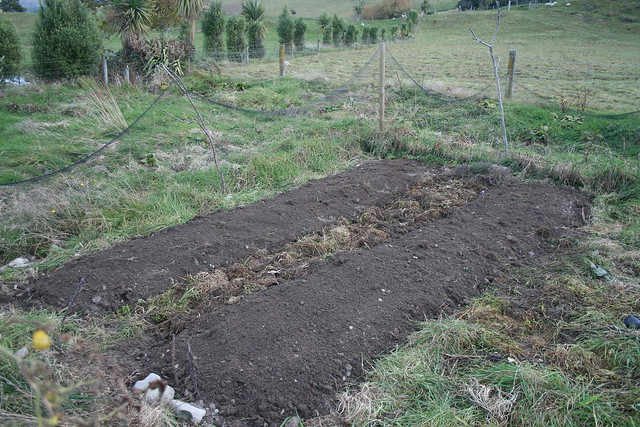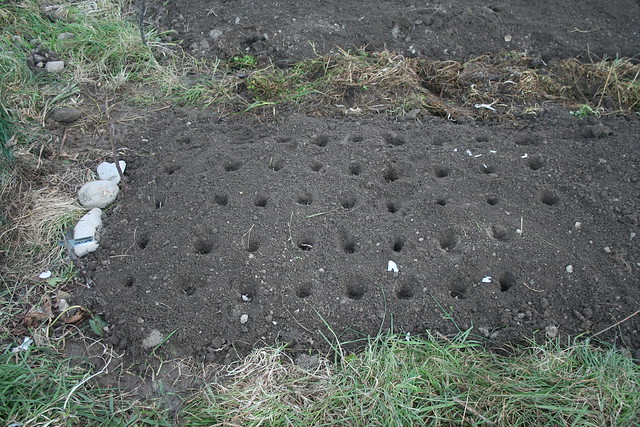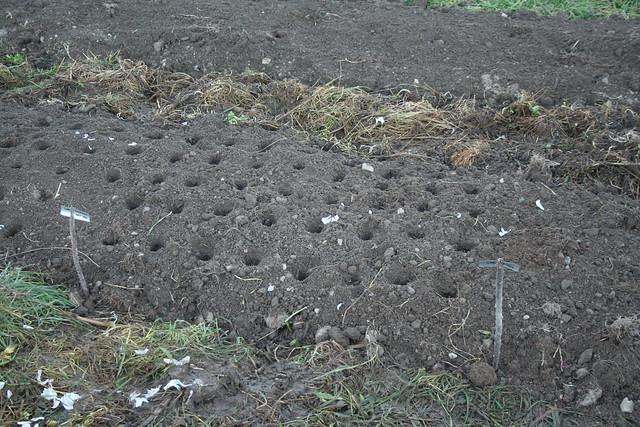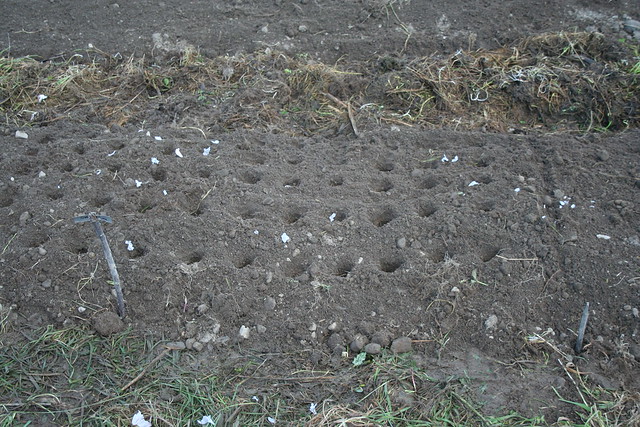Saturday, 25 June 2016
Friday, 24 June 2016
Cuttings and rooted canes
Yesterday, while pulling up the boysenberry canes from under the grass, and staking them up in a poor mans trellis, I managed to break a few of the canes. Noticing that they had white roots, I decided to try and pot them for later replanting.
Behind the boysenberry, are two planter bags of cuttings of what I believe to be heritage "Gabrier's Gully Gold Field" gooseberry that someone went out and retrieved. Named for the location, rather than any particular variety. And behind that are two more planter bags of Invicta gooseberry cuttings.
Posted by
Richard
at
2:59 pm
0
comments
![]()
Labels: boysenberry, cuttings, fruiting plants, gooseberry
Grapefruit seedling #1
This grapefruit plant was grown from seed, in theory there's another planted out alongside the road, but I've not been out to check to see if it still survives.
Will the fruit from this taste okay? It'll be another couple of years before I get the chance to find out, I guess. Worst comes to worst, I have loose plants to try grafting things like finger limes onto it, if the fruit it bears are not worth eating or giving away.
Posted by
Richard
at
1:24 pm
0
comments
![]()
Labels: farmlet, grapefruit, seedlings
Planting out blackcurrant cuttings
A lot of my existing blackcurrant cuttings I've planted out, are of unknown varieties. The reason for this is that any way where a name or date is written on plastic, results in faded unreadable plastic within several months to a year. After that, it comes down to where whatever it was, was planted. And how reliably the notes are, if there are any.
In this case, I must have started my new tagging regime. This involves taking segments of coke cans, and inscribing the variety name on them with a sharp implement. So I am almost certain these are Cotswold Cross blackcurrant cuttings.
And here they are planted out in the paddock. The ground is still damp from the rain last night, but I watered them in anyway. The stones are to prevent the chickens from scratching them out of the ground, as has happened before.
All of these have the coke can labels around them, and are labeled on an orchard map. I'll still need to confirm they are the variety I think they are, based on written and internet descriptions. But I'll need to do that for all my fruit, as more than a few have turned out to be other than described by whoever they were sourced from.
Posted by
Richard
at
1:21 pm
0
comments
![]()
Labels: blackcurrant, cuttings, farmlet
Poor mans berry trellis
Reading New Zealand fruit books and remembering what I read online, the gist was to cut away canes that had fruited, and to trellis the trailing canes for next year's fruit. However, one of the books says that generally brambles fruit on 2 year old canes, so how you identify what ones fruited last year I guess is a matter of experience.
I don't have the experience or tools to make a proper trellis, so I've just taken the poor man's approach. I basically uncovered all the trailing canes out of the surrounding grass, and tied them up the post with garden twine.
Here's the Tasman boysenberries:
And my neglected Brulee boysenberries. Unfortunately, these were set back when some grazing cattle ate them down to the ground. Their growth hasn't been spectacular since then.
I need to come up with a simple way of doing more extensive trellising.
Posted by
Richard
at
1:13 pm
0
comments
![]()
Labels: boysenberry, farmlet, trellis
Wednesday, 22 June 2016
Scionwood Exchange
In New Zealand, have fruit trees or bushes and can graft cuttings or wanting to try?
I'm exchanging cuttings from my fruit trees this Winter, with some other interested people who have their own selection of fruit trees/bushes. If you're googling for scions/cuttings for grafting in New Zealand and have your own selection to exchange, please comment and we'll get in touch.
Here's my exchange list for Winter 2016:
- Almond - Monovale
- Apple - Granny Smith
- Apple - Montys Surprise
- Apple - Peasgood Nonsuch
- Apple - Splendour
- Apple - Cider - Brown's Eater
- Apple - Cider - Kingston Black
- Apple - Cider - Lady Finger Cider
- Apple - Cider - Yarlington Mill
- Apricot - Cluthagold
- Apricot - Moorpark
- Apricot - Royal Rosa
- Apricot - Unknown (older tree)
- Cherry - Lapin
- Fig - Brown Turkey
- Fig - French Sugar
- Grape - Albany
- Mulberry - Black
- Nectarine - Fantasia
- Nectarine - Goldmine
- Olive - Frantoio
- Peach - Black Boy
- Peach - Golden Queen (from seed)
- Peach - Yellow (Unknown, mislabeled Black boy from nursery).
- Peach - Flatto (still need to look at tree to see if can take cuttings).
- Pear - Packham's Triumph
- Pear - Winter Nellis
- Pear - Taylor's Gold
- Plum - Black Amber
- Plum - Coes Golden Drop
- Plum - Greengage
- Plum - Hawera
- Plum - Prune - Italian
- Plum - Santa Rosa
- Plumcot
- Quince - Smyrna
- Walnut - Unknown (decent sized nuts, reliable bearer).
- Citrus, Grapefruit, Golden Special.
- Currant, Black, Magnus.
- Currant, Black, Cotswald Cross.
- Currant, Red, Unknown (mislabeled White Currant from Mitre 10)
- Currant, Red, Unknown (unlabeled from nursery).
- Currant, Red, Gloria de Versailles.
- Gooseberry, Invicta.
- Artichoke, Jerusalem.
- Comfrey, roots.
- Garlic, Takahue Red.
- Yacon.
Posted by
Richard
at
5:13 pm
0
comments
![]()
Labels: cuttings, fruit trees, scions
Sunday, 19 June 2016
Yam harvest - Winter 2016
There have been a few frosts and the yams have died back, so it's time to start harvesting before the grubs eat them all. Last year's harvest was a debacle and the grubs got most of them.
I planted late in January, as I had read that they don't really start growing until late anyway. Previous years I've put them in, in the Spring. But it doesn't seem necessary. I can't find the photos on flickr, so labelled and uploaded them.
2016-01-07: The bed has been dug and 90% of the stones put aside. The yams saved from last weeks harvest are sitting there in the egg cartons. They're survived the Winter pretty well, and the ones with cuts or damage were dipped in ash which seemed to do the trick.
2016-01-07: The yams all planted out.
2016-01-07: The netting has been laid down to prevent the free-ranging chickens from scratching the beds out, and a covering of hay has been scattered over top.
The bed pre-harvest today. Not bad looking considering the one time it was weeded, and perhaps two times it was watered. The problem with weeding was that pulling out the grass or whatever the weeds were, would easily pull out the yam roots. So it wasn't really possible to weed without damaging the crop.
Just pulling the netting off pulled out some of the better yams.
The recipient of the yams doing his own cleaning with the sieve I bought on recommendation from Rowan.
And the cleaned yams. I picked out 12 of the best and put them in a cupboard in an egg carton for next Spring's planting. I'll probably pick at least another two dozen as I harvest more.
Not bad for just the effort of one light weeding, perhaps two waterings (the Spring, Summer and Autumn were not that dry here), and the harvest of course.
Posted by
Richard
at
2:44 pm
0
comments
![]()
Labels: garden bed, harvest, oca, paddock, yams
Garlic Planting - Winter 2016
These are the first two of three garlic beds I've planted this year, both used for the broad bean landrace last year. There's a wider third bed which was dug and planted out in several days of hot weather.
Here are the varieties and the beds they're planted in:
- Bed 1: Ajo Rojo (Trade-Me, 2016)
- Bed 2: Rocambole Early White (Koanga, 2016)
- Bed 2: Rocambole Early Red (Koanga, 2016)
- Bed 2: New Zealand Purple (Koanga, 2016)
- Bed 3: Takahue Red (Koanga, 2014, replanted)
Bed 2: Rocambole - Early White.
Bed 2: Rocambole - Early Red.
Bed 2: New Zealand Purple.
No photos were taken of the planting in beds 1 and 3. I think some of the varieties were sprouting already, perhaps the Ajo Roja. My memory is failing me. I had wanted to get these in earlier, but was too busy to prepare the two existing beds, and dig out the third one.
Posted by
Richard
at
2:24 pm
0
comments
![]()
